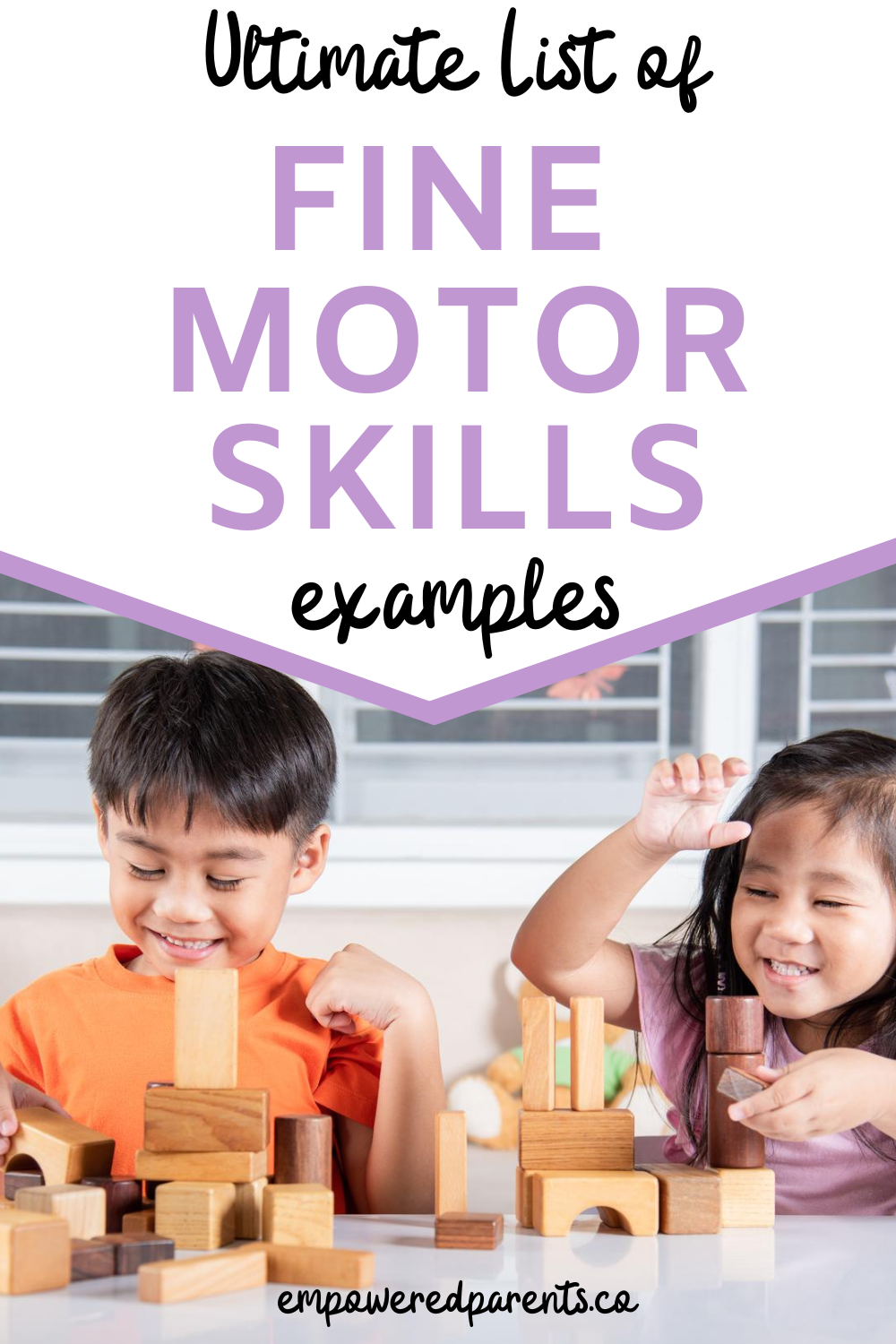In early childhood, children develop and learn to control the small muscles of their bodies, including the hands, fingers, eyes, tongue and toes. This is known as fine motor development.
Fine motor movements look different at various ages. A baby, for example, has to learn to hold a spoon while eating, whereas an older child learns to tie their shoes.
Some general examples of fine motor skills are:
- Picking up a toy with a pincer grasp
- Turning the pages of a book
- Placing pegs into a pegboard
- Buttoning a top
- Threading beads onto a string
- Drawing
- Writing
Below is a list of fine motor skills examples by age, from babies all the way up to children in primary/elementary school.
It lists some of the typical fine motor movements you can expect kids to do at certain ages.
Use it as a guideline only, as children develop at their own pace and may reach some milestones earlier or later.
Children develop their fine motor skills naturally through play but you can also plan fine motor activities that give them lots of opportunities to strengthen the small muscles of the body.
It’s also beneficial to give children access to a few, select fine motor toys to improve their fine motor skills – such as Lego, puzzles and lacing cards.
Here are the examples for infants, toddlers, preschoolers and children of school-going age.
The examples listed below are taken from the books “Language and School Readiness”, written by Martie Pieterse, and “From Birth to Five Years: Children’s Developmental Progress”, by Mary Sheridan.
Fine motor skills examples for infants
These examples are for infants up to about 18 months:
- Playing with fingers
- Clasping and unclasping hands
- Grasping and holding toys
- Putting objects in their mouth
- Clapping hands
- Following objects with eyes
- Holding a bottle
- Passing objects to someone
- Feeding with a spoon
- Pulling a toy with a rope
- Picking up objects with a pincer grasp (thumb and a finger)

Fine motor skills examples for toddlers
Here are some typical movements from around 18 months to 3 years:
- Pointing at pictures
- Picking up objects with a pincer grasp/ thumb and index finger
- Placing rings onto a stacking toy
- Holding crayons and scribbling or making lines and circular shapes
- Holding a paintbrush and making dots, strokes/lines and circles
- Using a palmar grasp (whole hand) and developing a tripod grasp (holding crayons with thumb and fingers)
- Building a small tower of blocks
- Placing pegs into a pegboard
- Transferring small objects into a tray
- Attempting to dress or undress
- Manipulating playdough
- Snipping paper with scissors
- Placing large pegs into a pegboard
- Building puzzles of 2 to 8 pieces

Fine motor skills examples for preschoolers
Children of ages 3 to 6 years develop these skills:
- Painting with paintbrushes of different sizes
- Holding crayons, pens and pencils with a tripod grasp, near the point
- Drawing pictures and pretend writing
- Drawing people with details, houses, animals and basic shapes
- Writing their name
- Dressing and undressing
- Brushing teeth, washing hands, combing hair and doing other self-care tasks
- Opening and closing a tap to wash hands
- Eating independently
- Tying shoelaces, fastening buttons and zips
- Controlling scissors and paper while cutting
- Gluing and pasting materials
- Doing finger plays
- Tearing paper
- Threading and lacing beads and string
- Building towers with blocks and manipulating construction toys
- Turning the pages of a book gently
- Hammering nails into a wooden board
- Using a preferred hand for most activities
- Building 12, 24 or 48-piece puzzles
- Creating constructions with waste materials
- Making playdough creations
- Preparing food – slicing, spreading, chopping, etc.

Fine motor skills examples for children in Elementary/Primary school
- Cutting neatly along straight and curvy lines
- Using a mature pencil grip
- Drawing pictures with fine details
- Writing letters and words along a line, in the correct size
- Threading fine beads onto a string
- Making intricate constructions
- Knitting
- Moulding playdough or clay into detailed objects
- Making paper-folding creations
- Preparing food

For more detail, here is a full list of fine motor milestones between the ages of 0 and 6, as well as some info on why fine motor skills are important.

